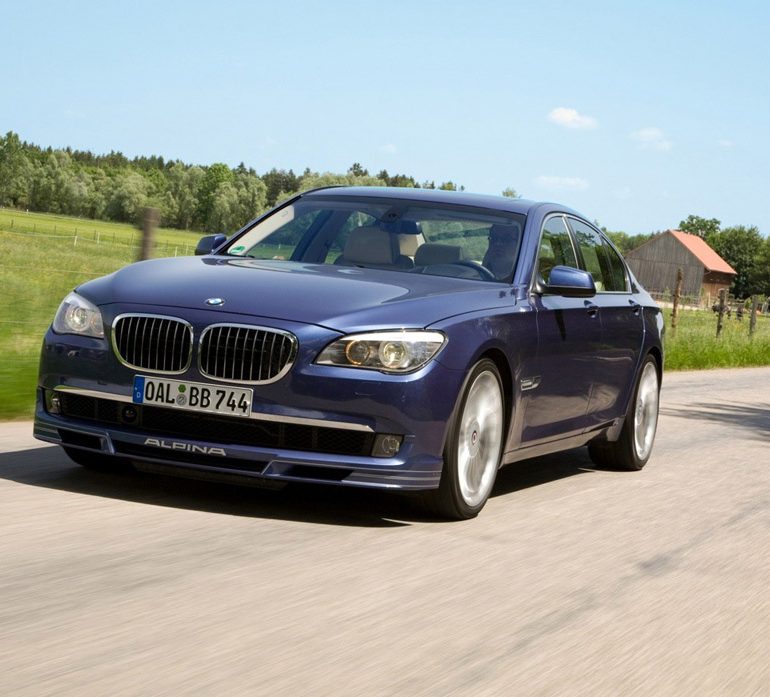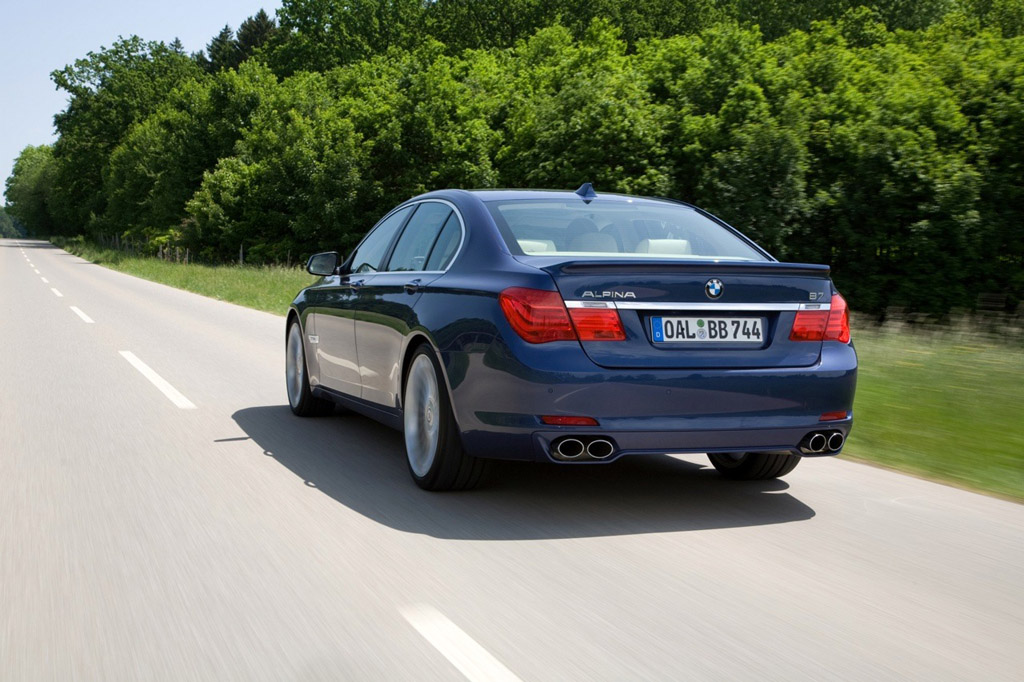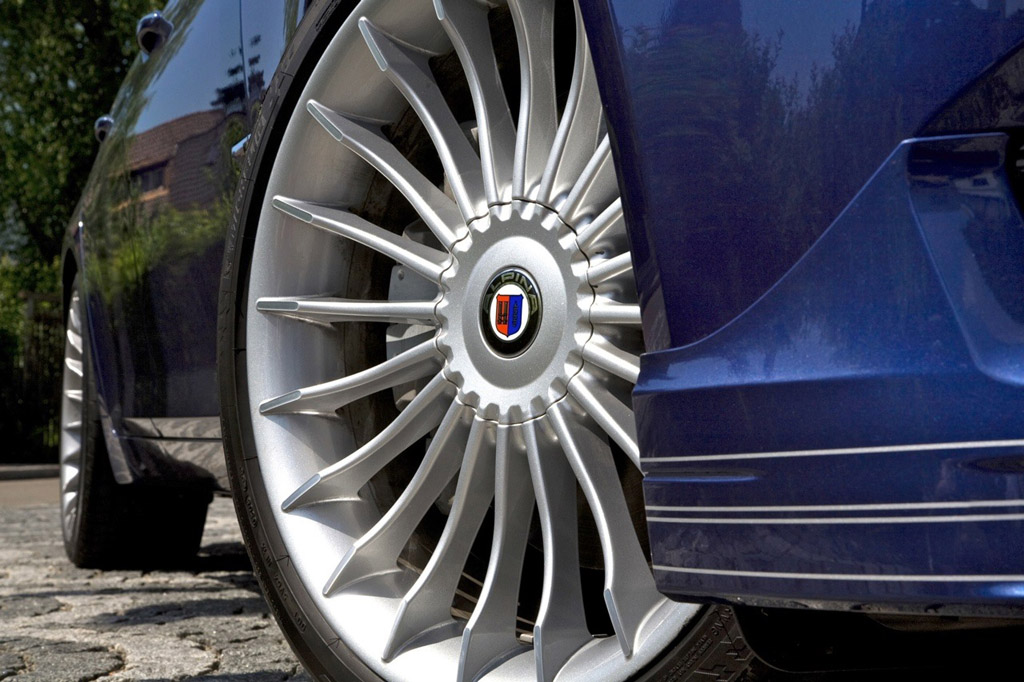2010 Alpina B7 Bi-Turbo
With the new BMW ALPINA B7 Bi-Turbo, ALPINA presents its fourth generation of automobiles based on the BMW 7 Series. Prominent predecessors include the BMW ALPINA B12 6.0 and B7, which raised the bar in the high-performance luxury saloon segment. Newly interpreted and in every way state-of-the-art, the B7 Bi-Turbo unites exclusiveness, athleticism and comfort in perfect harmony.
Yielding exquisite levels of torque and power from the charged 4.4 litre V8, and in conjunction with the electronically-adjustable suspension with active roll stabilisation, the B7 Bi-Turbo promises to offer a spectrum of driving experiences so varied as to be unheard of in this class of automobiles.
The evolution of the traditional 20-spoke 21” ALPINA CLASSIC wheels underline the fresh design language found throughout the B7 Bi-Turbo and impart it a distinctive appearance and powerful stance.
ALPINA and BMW. A history of synergy.
ALPINA – a name famous in Europe and the wider world for putting a particular performance accent on BMWs, though not yet so well-known in North America. BMW – a name famous all over the world for motor vehicles of performance, quality, luxury and safety.
The two companies, both at home in the German state of Bavaria, have a long history of working together to produce special BMW automobiles. Burkard Bovensiepen, son of the founder of ALPINA Business Machines and an enthusastic racing driver/engineer, began his automotive career path in 1961 by developing a dual-carburetor setup for the just-introduced BMW 1500 sedan. It was a predictive beginning: to take an already fine-performing BMW (which also just happened to be a practical sedan) and making it perform even better.
By 1964, BMW had officially recognized ALPINA’s contribution to BMW performance. Not long thereafter, Burkard Bovensiepen founded the ALPINA company – ALPINA Burkard Bovensiepen KG – that continues today, creating special versions of BMW automobiles that offer a particular brand of performance for discriminating auto enthusiasts. Yet outside the circle of dedicated BMW enthusiasts, ALPINA has kept a low profile in North America. In addition to racing versions of BMWs, ALPINA has developed a progression of BMW-based cars based on 3, 5, 6, 8, Z4 and Z8 models and offered them on a limited-production basis. ALPINA is located in the small Bavarian city of Buchloe, some 50 miles southwest of Munich, BMW’s headquarters city and the capital of Bavaria.
The B7 is the newest manifestation of the unique BMW-ALPINA synergy – once again based on the BMW 7 Series luxury sedan. Currently, BMW offers ultra-performance models of its 3, 5, 6, X5 and X6 Series developed by BMW M, BMW’s own performance subsidiary. For an ultra-performance version of the 7 Series – a vehicle defined by luxury and generous interior space – something other than “M” performance character was called for.
In recent models, ALPINA has concentrated on delivering very high levels of performance with moderate rpm ranges and automatic transmission. Most appropriately, the new BMW ALPINA B7 applies this philosophy to the newest 7 Series to produce a luxury sedan of stunning performance. “A 7 Series Beyond,” one might say.
Powertrain
The B7 sedan is equipped with BMW’s twin-turbocharged 4.4 liter, all-aluminum, High Precision Direct Injection V-8 engine which has been enhanced by ALPINA and is capable of producing 500 (373kW) horsepower and 516 lb-ft (700Nm) of torque. This rear-wheel drive performance/luxury Sedan achieves 0-60 mph in 4.5 sec. With maximum torque available across an unusually broad engine range, from 3,000 to 4,750 rpm, the B7 accelerates effortlessly from virtually any speed.
The two turbochargers operate in parallel, with generously-dimensioned turbine vanes measuring 44mm in diameter. Thorough exploitation of the engine’s potential was achieved by means of optimizing the indirect intercooler (air-water/water-air) with its short intake paths and flow-optimized intercooler tracts. All three intercoolers, the low-temperature intercooler integrated into the radiator package, as well as the two near-engine intercoolers are enlarged by approximately 35%, ensuring very high thermodynamic efficiency. High-performance pistons have been specified to withstand the thermodynamic forces created by a 9.2:1 compression and a maximum turbo boost of 1.0 bar. The result is a formidable specific output of 115hp (85kW) per liter, with a maximum average compression of 20.1 bar, a benchmark even amongst established sports cars.
This wide power band coupled with the six-speed sport automatic transmission gives the driver remarkably high levels of power and capability in every driving situation. The ALPINA SWITCH-TRONIC transmission control offers tailored shift characteristics for every driver and situation thanks to its Sport and Manual modes. To manually select the gears of the automatic transmission, the driver may use buttons found on the back of the ALPINA-tailored steering wheel. This results in shifts which take place in a few hundred milliseconds with minimal power interruption.
Ending in two polished double-tailpipes, the stainless-steel ALPINA exhaust system offers up that deep and sonorous yet not intrusive V8 sound that enthusiasts have come to expect from ALPINA.
Chassis & Suspension
The BMW ALPINA B7 builds on the state-of-the-art adaptive suspension technologies of the 7 Series, including tuned Dynamic Damping Control and Active Roll Stabilization, to the demanding requirements of a high performance sedan. Long gone are the days when a purely “hard and sporty” ride was a sought-after attribute of suspension set-ups. Striving for truly neutral handling continues to be the goal, yielding the best of what is technologically feasible. In pursuit of this goal, shorter and uniquely calibrated springs reduce front and rear ride height by 15mm and 10mm respectively. Dynamic Damping Control and Active Roll Stabilization enable the driver to select from three distinct suspension set-ups: Comfort, Normal and Sport. These are intentionally calibrated to provide noticeably different set-ups, influencing the characteristic of the dampers, the Active Roll Stabilization as well as the parameters of the power steering assist, throttle response algorithms and load-reversal damping. The Sport-Plus mode automatically shifts the Dynamic Stability Control system into Dynamic Traction Control (DTC). This allows noticeably more slip at the driven wheels and delayed intervention by the traction control system.
Together with the 21″ wheel and tire combination, the suspension is at once sensitive to inputs and direct in its feel, yet free from the harshness of a purely sports-oriented suspension. The light-weight 21″ wheels, with their new interpretation of the ALPINA CLASSIC wheel design, are shod with a specially selected staggered MICHELIN PS2 tire set-up: 245/35 R21 front and 285/30 R21 rear.
The result is that the BMW ALPINA B7 captures an agility associated with much smaller sedans, while preserving the ride quality associated with the BMW 7 Series.
Design
The B7 sedan is finished with ALPINA aerodynamic developments, including front and rear spoilers which not only enhance the appearance but also improve stability and performance at high speeds. In true “form-follows-function” fashion, the ALPINA front integrates the fresh-air requirements of the transmission and engine oil coolers, which are separated out of the main cooler module for improved efficiency. The spoilers reduce lift at the front by 30% and rear by15%. The exhaust system’s two double tailpipes are seamlessly integrated into the rear bumper. The newest evolution of the traditional 20-spoke ALPINA CLASSIC wheels gives the B7 a distinctive appearance and powerful stance.
The interior of the B7 sedan features ALPINA blue illuminated door sill trims, the SWITCH-TRONIC steering wheel in hand-stitched LAVALINA leather, and the Black-Panel LCD screen instrument cluster branded with ALPINA. Exclusive interior luxury wood trim in the form of Myrtle Burl, a knotted burl of the Laurel only found on the Pacific Coast of the United States, provides a warm and traditional ambience. Optional ALPINA Piano Lacquer interior trim with its silver diagonal rhombs, offers a modern alternative.
The full complement of BMW 7 Series exterior colors remains available, in addition to the signature ALPINA Blue metallic paint.
Discreet metal ALPINA emblems adorn the upper seatbacks of the standard leather Comfort seats and are inlayed in the wood trim. An additional ALPINA plaque indentifying the car is mounted on the inner roof panel just ahead of the sunroof. Even the engine bay carries a subtle signature by tidily presenting itself with a newly-designed ALPINA engine cover.
Story by Alpina
In Detail
| type | Professionally Tuned Car |
| released at | 2009 Frankfurt Motor Show |
| built at | Buchloe, Germany |
| price $ | $ 122,875 |
| engine | 90° V8 |
| position | Front, Longitudinal |
| aspiration | Twin Turbochargers |
| fuel feed | Direct Injection |
| displacement | 4395 cc / 268.20 in³ |
| bore | 89 mm / 3.5 in |
| stroke | 88.3 mm / 3.5 in |
| compression | 9.2:1 |
| power | 378.1 kw / 507 bhp @ 5500 rpm |
| specific output | 115.36 bhp per litre |
| bhp/weight | 248.53 bhp per tonne |
| torque | 700 nm / 516.3 ft lbs @ 3000 rpm |
| body / frame | Unitary Steel Monocoque |
| driven wheels | RWD |
| wheel type | Alpina Classic 21 |
| front tires | 245/35 R21 |
| rear tires | 285/30 R21 |
| front wheels | F 53.3 x 25.4 cm / 21 x 10 in |
| rear wheels | R 53.3 x 21.6 cm / 21 x 8.5 in |
| curb weight | 2040 kg / 4498 lbs |
| wheelbase | 3070 mm / 120.9 in |
| front track | 1621 mm / 63.8 in |
| rear track | 1628 mm / 64.1 in |
| length | 5087 mm / 200.3 in |
| width | 1902 mm / 74.9 in |
| height | 1478 mm / 58.2 in |
| transmission | ZF 6HP26 6-Speed Automatic |
| gear ratios | 4.17:1, 2.34:1, 1.52:1, 1.14:1, 0.87:1, 0.69:1 |
| final drive | 3.46:1 |
| top speed | ~280 kph / 173.88 mph |
| 0 – 100 kph | ~4.7 seconds |
| urban fuel econ eu | 17.4 L/100 km or 13.52 mpg-us |
| extra urban fuel econ eu | 9.0 L/100 km or 26.13 mpg-us |
| combined fuel econ eu | 12.1 L/100 km or 19.44 mpg-us |
| emission | 282 g/km |
| fuel capacity | 82 litres or 21.65 gal. |







